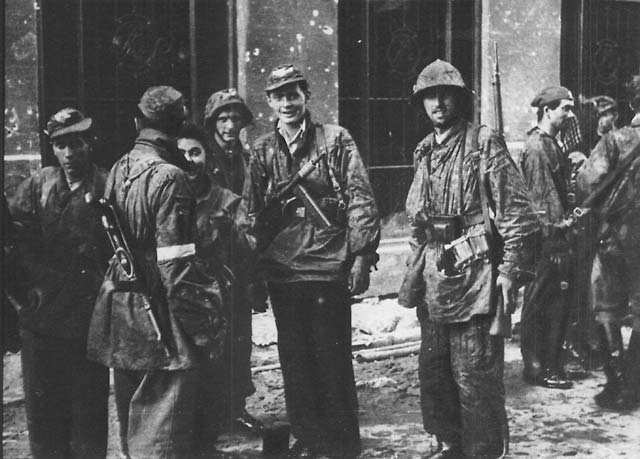During the two-month-long armed struggle (exactly 63 days) in Warsaw, losses on the Polish side amounted to approximately 16,000 dead and missing, 20,000 wounded and 15,000 captured. In addition, as a result of German artillery shelling, air raids, planned massacres organised by the Germans and the harsh insurgent conditions, 150,000 to 180,000 civilian inhabitants of the capital died. The buildings of left-bank Warsaw were irretrievably destroyed including numerous monuments and objects of great material, cultural and spiritual value.
The Warsaw Uprising began on 1 August at 5 p.m., the so-called “W” hour. The decision to break out was made by the Home Army Commander-in-Chief Tadeusz Komorowski “Bor”, in agreement with political figures. This military action, was directed against the German occupant, and politically against the USSR and Polish communists subordinated to that superpower, in order to prevent the Sovietisation of Poland and at the same time to strengthen the position of the Polish government in exile in negotiations with the Allies about the future shape of borders in Europe.
On the day of the outbreak of the Warsaw Uprising, the Warsaw District of the Home Army and the Kedyw (Diversion of the Main Headquarters) numbered over 40,000 soldiers, and together with the Home Army’s regular forces – as many as 58,000. However, between 25,000 and 37,000 people joined the armed struggle against the German occupier. Due to the conspiracy, not all of them managed to reach the assembly points in time and retrieve weapons from caches and warehouses. In the course of post-war research work, information was collected on 48,183 people who were identified as soldiers of the Uprising. However, not everyone fought at the same time. The Uprising was led by the commander of the Warsaw-City Home Army District, Colonel Antoni Chruściel “Monter”. He led it to the very end, i.e. until 2 October 1944, when the surrender took place.
In addition to men, women also took part in the Uprising, making up 14% of the soldiers. Children also participated in the fight. The youngest insurgent was Jerzy Szulc a.k.a. “Tygrys”, who was 10 years old (the participation of children and young people in the Uprising is commemorated by a monument to the Little Insurgent unveiled in 1983). Most of the insurgents were soldiers of the Home Army. Members of other independence armed formations and Jewish fighters also joined the fighting.
During the uprising, women also served as doctors, paramedics, and nurses (in the sanitary service – they made up about 70-80 per cent of the personnel), liaison officers and guides in the sewers. The Women’s Miner Patrols, meanwhile, took part in combat actions, while the Women’s Diversion and Sabotage unit, among other things, prepared signals for Allied airmen and received airdrops. On 12 August 1944, Colonel Antoni Chruściel “Monter” issued an order recognising woman who had taken the oath during the period of conspiracy and were counted as soldiers of the Home Army.
Home Army soldiers did not have uniforms; they fought in civilian clothes. They wore white and red armbands on their shoulders and sometimes wore Polish eagles on their caps. The fight of the insurgents was hampered by shortages, especially of weapons and ammunition. On 1 August 1944, the soldiers had only 2,500 pistols, 1,475 rifles, 420 submachine guns, 94 hand machine guns, and 20 heavy machine guns at their disposal. There were also weapons produced by the AK in-house, i.e. flamethrowers, incendiary bottles, ‘lightning’ guns and grenades. All of this in numbers allowed to arm only a few thousand rather than over twenty thousand men. Weapons and ammunition were either obtained from the enemy or received through Allied airdrops. In the face of bombardments by the Luftwaffe and Wehrmacht artillery, however, the insurgents had little chance to win.
The Germans were extremely cruel to the people of Warsaw and the insurgents. Hitler and Himmler wanted to raze Warsaw to the ground and ordered the murder of every inhabitant. This task was entrusted to SS-Obergruppenführer and police general Erich von dem Bach-Zelewski.
In the first days of August, in accordance with Himmler’s instructions, everyone was murdered without distinction of sex or age (the slaughter of Wola). Then, on 5 August 1944, the commander of the German troops forbade the murder of women and children, and on 12 August the murder of male civilians. Finally, the decision was made to kill only insurgents. However, it was not always followed. Executions of civilians took place for almost the entire duration of the fighting. The wounded who were in the insurgent hospitals were also killed.
In August 1944, the Soviet press referred to the uprising as “an action of fascist, reactionary Polish circles”. In accordance with Stalin’s order of 5 August 1944, the Red Army’s offensive toward Warsaw was halted. Stalin only authorised a local operation by the Polish Army’s 1st Army to cross the Vistula and establish communication with the insurgents. Carried out in the second half of September 1944, the landing of a relatively few troops, without adequate artillery support, ended in failure. Between 2,500 and 3,500 soldiers were killed during the operation.
As the legendary ‘courier from Warsaw’ – Jan Nowak-Jeziorański – wrote after the war, ‘the struggle was not in vain, and the Warsaw Uprising meant that ‘the Polish state, although enslaved and vassalized, retained its distinctiveness, surviving Stalin, who in his intentions probably wanted to make it part of the USSR’.





